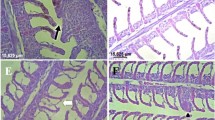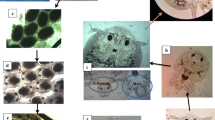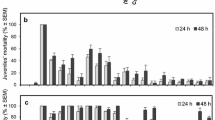Abstract
This study evaluated the potential of alternative treatments against larval stages of Lernaea cyprinacea. For in vitro test, the nanoemulsified oils of Pinus sp. acicule and oleoresin were evaluated, along with Biogermex® (commercial product based on citrus biomass). For this, the motility of five larvae of the same stage (nauplii or copepodite) were evaluated in a 96-well microplate. Using the best results, on the in vivo test, fries of Rhamdia quelen were submitted to a long-term immersion bath (96 h) containing different concentrations of the product diluted directly in the water. It was possible to notice the antiparasitic potential of the oleoresin and the acicule of Pinus sp., as well as the citrus biomass extract against the parasites. The nanoemulsified oils successfully inhibited the development of nauplii (10 mg L−1 in 24 h) and the fries showed to be tolerant to the presence of the compound (LC50 96 h—16.74 mg L−1). The concentration of 30.5 mg L−1 of Biogermex® eliminated the copepodites within 24 h, being more efficient than Pinus sp. when tested at the same stage, at the times analyzed. The results obtained indicate a potential use of these compounds as prophylactic agents against L. cyprinacea.



Similar content being viewed by others
Data Availability
The data that support the findings of this study are available from the corresponding author upon reasonable request.
References
Baldisserotto B, Radünz NJ (2004) Criação de Jundiá. Editora da Universidade Federal de Santa Maria, Santa Maria
Barry MJ, Logan DC, Van Dam RA, Ahokas JT, Holdway DA (1995) Effect of age and weight-specific respiration rate on toxicity of esfenvalerate pulse-exposure to the Australian crimson-spotted rainbow fish (Melanotaenia fluviatilis). Aquat Toxicol 32:115–126. https://doi.org/10.1016/0166-445X(94)00084-4
Bouboulis D, Athanassopoulou F, Tyrpenou A (2004) Experimental treatments with diflubenzuron and deltamethrin of sea bass, Dicentrarchus labrax L., infected with the isopod, Ceratothoa Oestroides. J Appl Ichthyol 20:314–317. https://doi.org/10.1111/j.1439-0426.2004.00579.x
Boxshall GA, Montú MA, Schwarzbold A (1997) A new species of Lernaea L. (Copepoda: Cyclopoida) from Brazil, with notes on its ontogeny. Syst Parasitol 37:195–205. https://doi.org/10.1023/A:1005899405901
Branson EJ, Rønsberg SS, Ritchie G (2000) Efficacy of teflubenzuron (Calicide®) for the treatment of sea lice, Lepeophtheirus salmonis (Krøyer 1838), infestations of farmed Atlantic salmon (Salmo salar L.). Aquac Res 31:861–867. https://doi.org/10.1046/j.1365-2109.2000.00509.x
Burridge L, Weis JS, Cabello F, Pizarro J, Bostick K (2010) Chemical use in salmon aquaculture: a review of current practices and possible environmental effects. Aquaculture 306:7–23. https://doi.org/10.1016/j.aquaculture.2010.05.020
Burtle G, Morrison J (1987) Dimilin for control of Lernaea in golden shiner ponds. J Ark Acad Sci 41:17–19
Chakraborty SB, Hancz C (2011) Application of phytochemicals as immunostimulant, antipathogenic and antistress agents in finfish culture. Rev Aquac 3:103–119. https://doi.org/10.1111/j.1753-5131.2011.01048.x
Chhabra RS, Huff JE, Haseman JK, Elwell MR, Peters AC (1991) Carcinogenicity of p-chloroaniline in rats and mice. Food Chem Toxicol 29:119–124. https://doi.org/10.1016/0278-6915(91)90166-5
Corrêa LL, Tavares-Dias M, Ceccarelli PS, Adriano EA (2016) Hematological alterations in Astyanax altiparanae (Characidade) caused by Lernaea cyprinacea (Copepoda: Lernaeidae). Dis Aquat Org 120:77–81. https://doi.org/10.3354/dao03008
Egidius E, Moster B (1987) Effect of Neguvon® and NUVAN® treatment on crab (Cancer pagurus, C. maenas), lobster (Homarus gammarus) and blue mussel (Mytilus edulis). Aquaculture 60:165–168. https://doi.org/10.1016/0044-8486(87)90309-7
Eisler R (1992) Diflubenzuron hazards to fish, wildlife and invertebrates: a synoptic review. Department of the Interior Fish and Wildlife Service, Washington
Ellis AE (1988) Ontogeny of the immune system in the teleost fish. In: Ellis AE (ed) Fish vaccination. Academic Press, New York, pp 20–31
Hakalahti-Sirén T, Mikheev VN, Valtonen ET (2008) Control of freshwater fish louse Argulus coregoni: a step towards an integrated management strategy. Dis Aquat Org 82:67–77. https://doi.org/10.3354/dao01971
Hamilton MA, Russo RC, Thurston RV (1977) Trimmed Spearman-Karber method for estimating median lethal concentrations in toxicity bioassays. Environ Sci Technol 11:714–719. https://doi.org/10.1021/es60130a004
Hashimoto GSO, Neto FM, Ruiz ML, Acchile M, Chagas EC, Chaves FCM, Martins ML (2016) Essential oils of Lippia sidoides and Mentha piperita against monogenean parasites and their influence on the hematology of Nile tilapia. Aquaculture 450:182–186. https://doi.org/10.1016/j.aquaculture.2015.07.029
Hrubec TC, Ward D, Smith SA, Robertson JL (2004) Age related changes in humoral immune response of hybrid striped bass (Morone chrysops × Morone saxatilis). Vet Immunol Immunopathol 101:103–108. https://doi.org/10.1016/j.vetimm.2004.04.020
Kabata Z (1979) Parasitic Copepoda of British Fishes. The Ray Society, Londres
Kirby GC (1996) Medicinal plant and control of protozoan disease with particular reference to malaria. Trans R Soc Trop Med Hyg 90:605–609. https://doi.org/10.1016/s0035-9203(96)90404-6
Kone M, Cisse M, Affourmou K, Soric RE, Fantodji A, Miron DL (2013) In vivo antiparasitic effects of an African’s traditional plant Ocimum gratissimum (Linneaus 1758) on fish louse Argulus spp. infesting the Nile tilapia males Oreochromis niloticus (Linneaus 1758) in fish farming. Open J Vet Med. https://doi.org/10.7392/openaccess.23050447
Lahav M, Sarig S, Shilo M (1964) The eradication of Lernaea in storage ponds of carp through destruction of the copepodal stage by Dipterex. Bamidegh. Bulletin of Fish Culture in Israel 16:87–97
Leandro LF, Cardoso MJO, Silva SDC, Souza MGM, Veneziani RCS, Ambrosio SR, Martins CHG (2014) Antibacterial activity of Pinus elliottii and its major compound, dehydroabietic acid, against multidrug-resistant strains. J Med Microbiol 63:1649–1653. https://doi.org/10.1099/jmm.0.081711-0
Mabilia RG, Souza SMG (2006) Efeito do tratamento com diflubenzuron na hematologia de jundiás, Rhamdia quelen (Pimelodidae) infestados por Lernaea cyprinacea (Copepoda) em banhos de imersão de 24 horas. Acta Sci Biol Sci 28:159–163
Malheiros DF, Sarquis IR, Ferreira IM, Mathews PD, Mertins O, Tavares-Dias M (2020) Nanoemulsions with oleoresin of Copaifera reticulata (Leguminosae) improve anthelmintic efficacy in the control of monogenean parasites when compared to oleoresin without nanoformulation. J Fish Dis 43:687–695
Mamprim AP, Alves LFA, Pinto FGS, Formentini MA, Martins CC, Pares RB (2014) Effect of phytosanitary products on biological parameters of Beauveria bassiana (Bals.) Vuill. (Hypocreales: Cordycipitaceae). Rev Prot Veg 29:128
Nagnom P, Clement JL (1990) Terpenes from maritime pine (Pinus pinaster): toxins for subterranean termites of the genus Reticulitermes. Biochem Syst Ecol 18:13–16. https://doi.org/10.1016/0305-1978(90)90025-B
Noga EJ (2010) Fish disease: diagnosis and treatment, 2nd edn. Wiley-Blackwell, Iowa
Pares RB, Alves LFA, Mamprim AP, Bonini AK (2017) Alternative phytosanitary products against to white muscardine in Bombyx mori L. (Lepidoptera: Bombycidae). Arq Inst Bio 84:1–7. https://doi.org/10.1590/1808-1657000642015
Pillay TVR (2004) Aquaculture and the environment, 2nd edn. Blackwell, Oxford
Radünz NJ (2004) Manejo Alimentar – Nutrição. In: Baldisserotto BE, Radünz, NJ Criação de Jundiá. Editora da Universidade Federal de Santa Maria, Santa Maria
Raghavendra A, Jaswal RS, Hemaprasanth KP, Soumya CB (2018) Efficacy of neem seed extracts on developmental stages of Lernaea cyprinacea. Iran J Fish Sci 19:1864–1870
Robinson J, Avenant-Oldewage A (1996) Aspects of the morphology of the parasitic copepod Lernaea Cyprinacea Linnaeus, 1758 and notes on its distribution in Africa. Crustaceana 69:610–626. https://doi.org/10.1163/156854096X00628
Rodrigues EL, Ranzani-Paiva MJT, Juliano F (2001) Histopathologic lesions in the liver of Prochilodus lineatus (Pisces, Prochilodontidae) exposed to a sublethal concentration of the organophosphate insecticide Dipterex 500® (Trichlorfon). Acta Sci Biol Sci 23:503–505
Salem MZ, Zidan YE, Mansour MM, Hadidi NM, Elgat WAA (2016) Antifungal activities of two essential oils used in the treatment of three commercial woods deteriorated by five common mold fungi. Int Biodeterior Biodegradation 106:88–96. https://doi.org/10.1016/j.ibiod.2015.10.010
Samuelsen OB, Lunestad BT, Hannisdal R, Bannister R, Olsen S, Tjensvoll T, Farestveit E, Ervik A (2015) Distribution and persistence of the anti sea-lice drug teflubenzuron in wild fauna and sediments around a salmon farm, following a standard treatment. Sci Total Environ 508:115–121. https://doi.org/10.1016/j.scitotenv.2014.11.082
Shariff FM, Kabata Z, Sommerville C (1986) Host susceptibility to Lernaea cyprinacea L. and its treatment in a large aquarium system. J Fish Dis 9:393–401. https://doi.org/10.1111/j.1365-2761.1986.tb01032.x
Shields RJ, Tidd WM (1968) Effect of temperature on the development of larval and transformed females of Lernaea cyprinacea L. (Lernaeidae). Crustaceana, pp 87–95
Silfvergrip A (1996) A systematic revision of the Neotropical catfish genus Rhamdia (Teleostei, Pimelodidae). Dissertation, Stockholm University
Silva ERL, Alves LFA, Martinelo L, Fromentini MA, Marchese LPC, Pinto FGS, Potrich M, Neves PMOJ (2012) Natural phytosanitary products effects on Bacillus thuringiensis subsp. kurstaki (Berliner). Semin Cienc Agrar 33:2891–2904. https://doi.org/10.5433/1679-0359.2012v33Supl1p2891
Silva SDC, Souza MGM, Cardoso MJO, Moraes TS, Ambrósio SR, Veneziani RCS, Martins CHG (2014) Antibacterial activity of Pinus elliottii against anaerobic bacteria present in primary endodontic infections. Anaerobe 30:146–152. https://doi.org/10.1016/j.anaerobe.2014.09.013
Soile J, Janet A, Roger A (1990) Monoterpene emission rate measurements from a Monterey pine. J Geophys Res Atmos 95:7515–7519. https://doi.org/10.1029/JD095iD06p07515
Takemoto RM, Luque JS, Bellay S, Longhini CE, Graça RJ (2013) Monogenea. Pavanelli GC, Takemoto RM. Eiras JC Parasitologia de peixes de água doce do Brasil. Editora da Universidade Federal de Santa Maria, Maringá, pp 273–299
Tascioglu C, Yalcin M, Sen S, Akcay C (2013) Antifungal properties of some plant extracts used as wood preservatives. Int Biodeterior Biodegradation 85:23–28. https://doi.org/10.1016/j.ibiod.2013.06.004
Tatner MF, Manning MJ (1983) Growth of the lymphoid organs in rainbow trout, Salmo gairdneri from one to fifteen months of age. J Zool 199:503–520. https://doi.org/10.1111/j.1469-7998.1983.tb05102.x
Tavares-Dias M, Martins ML (2017) An overall estimation of losses caused by diseases in the Brazilian fish farms. J Parasit Dis 41:913–918. https://doi.org/10.1007/s12639-017-0938-y
Tóro RM, Gessner AAF, Furtado NAJC, Ceccarelli PS, Albuquerque S, Bastos JK (2003) Activity of the Pinus elliottii resin compounds against Lernaea cyprinacea in vitro. Vet Parasitol 118:143–149. https://doi.org/10.1016/j.vetpar.2003.08.008
Tsuchiya H, Sato M, Miyazaki T, Fujiwsara S, Tanigaki S, Ohyama M, Tanaka T, Linuma M (1996) Comparative study on the antibacterial activity of phytochemical flavanones against methicillin-resistant Staphylococcus aureus. J Ethnopharmacol 50:27–34. https://doi.org/10.1016/0378-8741(96)85514-0
Valladão GMR, Gallani SU, Pádua SB, Martins ML, Pilarski F (2014) Trichodina heterodentata (Ciliophora) infestation on Prochilodus lineatus larvae: a host-parasite relationship study. Parasitology 141:662–669. https://doi.org/10.1017/S0031182013001480
Valladão GMR, Gallani SU, Pilarski F (2015) Phytotherapy as an alternative for treating fish disease. J Vet Pharmacol Ther 38:417–428. https://doi.org/10.1111/jvp.12202
Vivanco JM, Cosi E, Loyola-Vargas VM, Flores HE (2009) Los mecanismos químicos de defensa en las plantas. Investig Cienc 341:68–75
Wang JL, Meng XL, Lu RH, Wu C, Luo YT, Yan X, Li XJ, Kong XH, Nie GX (2015) Effects of Rehmannia glutinosa on growth performance, immunological parameters and disease resistance to Aeromonas hydrophila in common carp (Cyprinus carpio L.). Aquaculture 435:293–300. https://doi.org/10.1016/j.aquaculture.2014.10.004
Acknowledgements
The authors thank the National Council for Scientific and Technological Development (CNPq) [M.L. Martins (CNPq 305869/ 2014-0, 306635/2018-6) e CNPq 446072/ 2014-1)]; the Coordination of Improvement of Higher Education Personnel, Brazil (CAPES)—Finance Code 001 for financed part of this study; CAPES for Master Science Scholarship to W.E. Furtado. Also, the authors thank the Company of Agricultural Research and Rural Extension of Santa Catarina (EPAGRI/Cedap) for the donation of the animals used in this study.
Author information
Authors and Affiliations
Contributions
WF worked on the assessment, system`s maintenance, processing of the material analyzed, and wrote the first draft of the manuscript. LC, PM, NL and EB were the technical team who assisted during the assessment of the alternative treatments. MM, FB, and NM contribute with the data analysis and article editing. All authors contributed to the article and approved the submitted version.
Corresponding author
Ethics declarations
Conflict of interest
The authors have no conflicts of interest to declare.
Human and animal rights
All the animal procedures used in this project was approved by the Ethic Committee on Animal Use of Federal University of Santa Catarina (CEUA/UFSC/PP00928).
Additional information
Publisher's Note
Springer Nature remains neutral with regard to jurisdictional claims in published maps and institutional affiliations.
Rights and permissions
About this article
Cite this article
Furtado, W.E., Cardoso, L., de Medeiros, P.B. et al. Antiparasitic potential of alternative treatments against larval stages of Lernaea cyprinacea. J Parasit Dis 45, 1096–1105 (2021). https://doi.org/10.1007/s12639-021-01400-2
Received:
Accepted:
Published:
Issue Date:
DOI: https://doi.org/10.1007/s12639-021-01400-2




